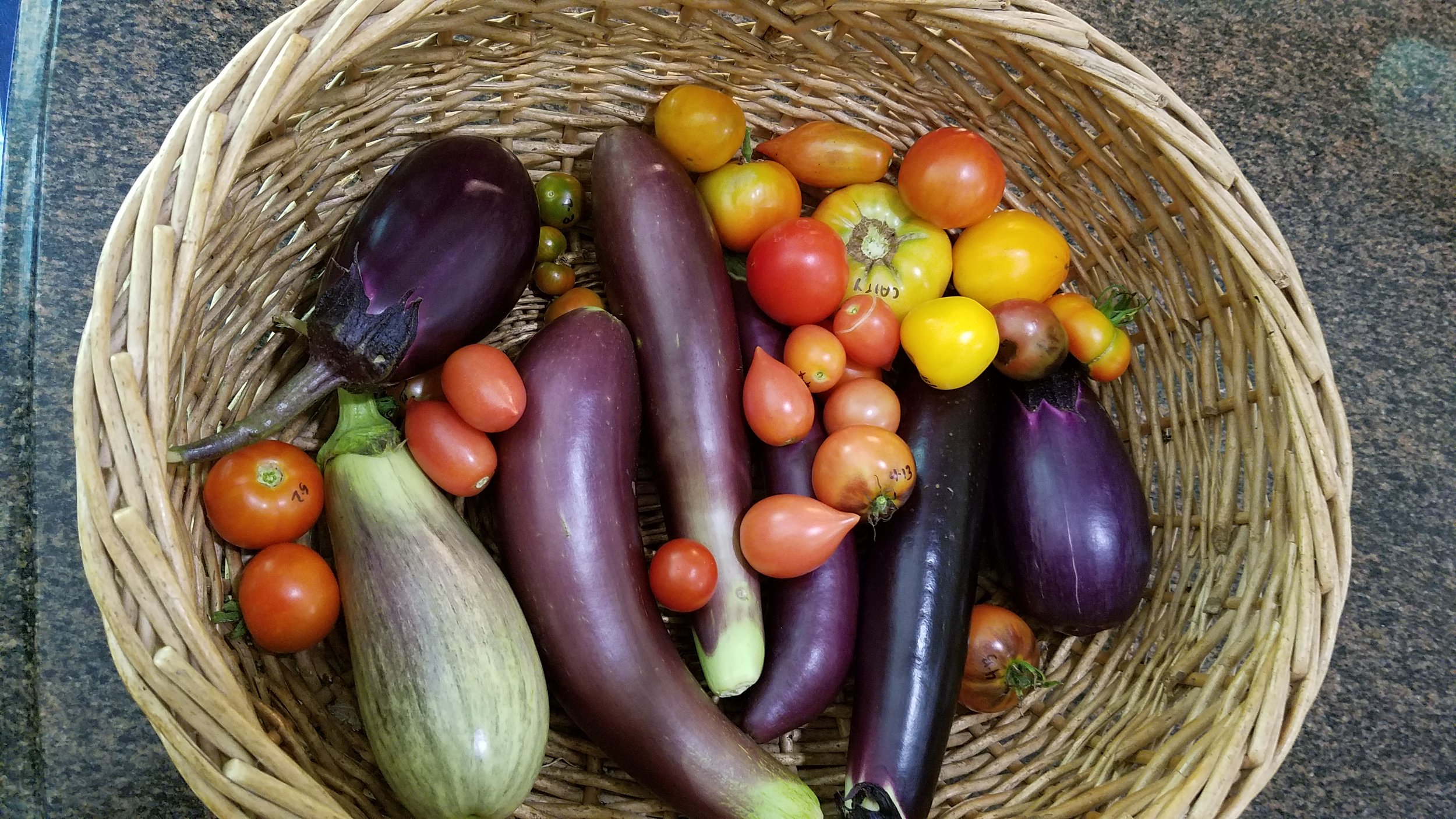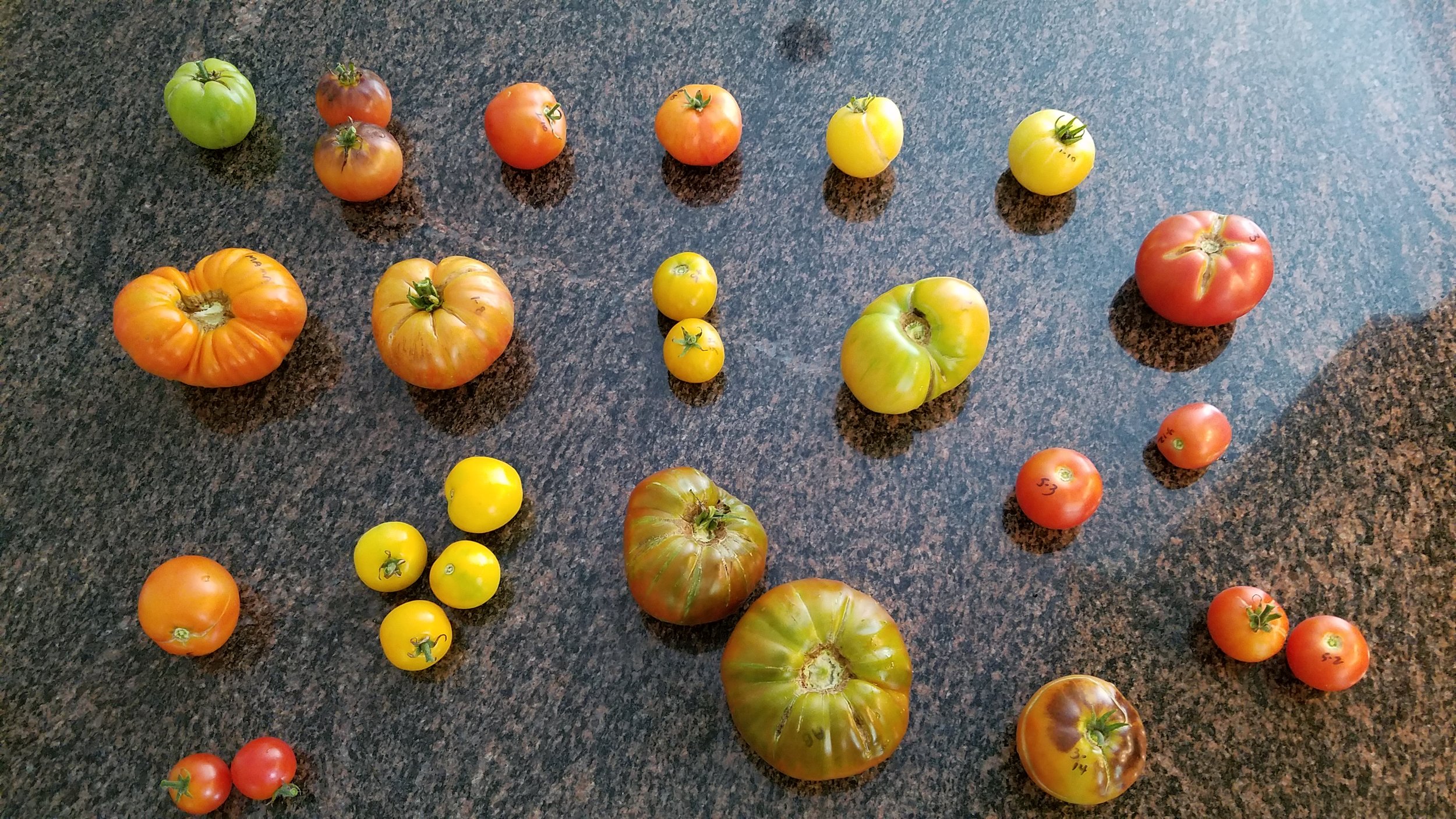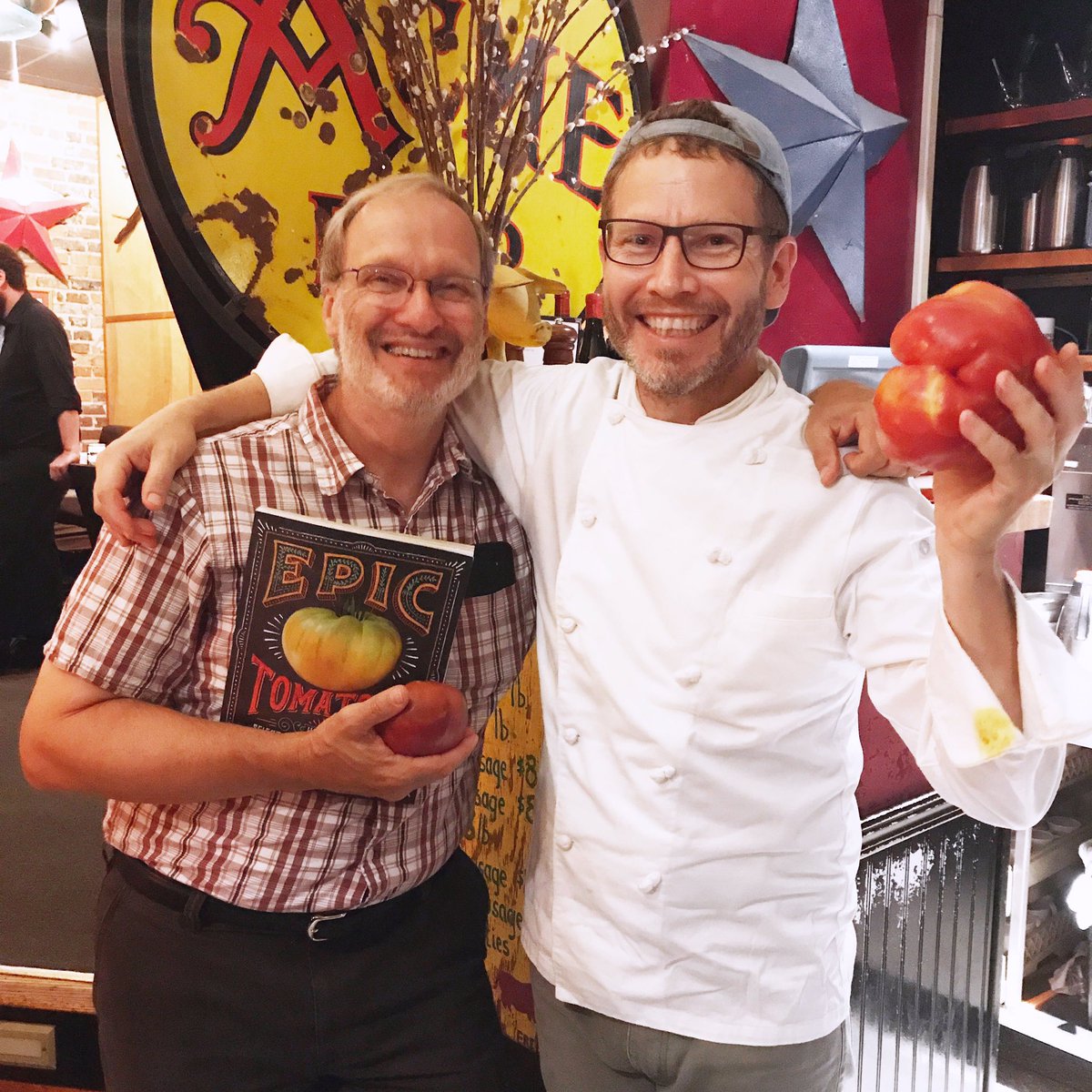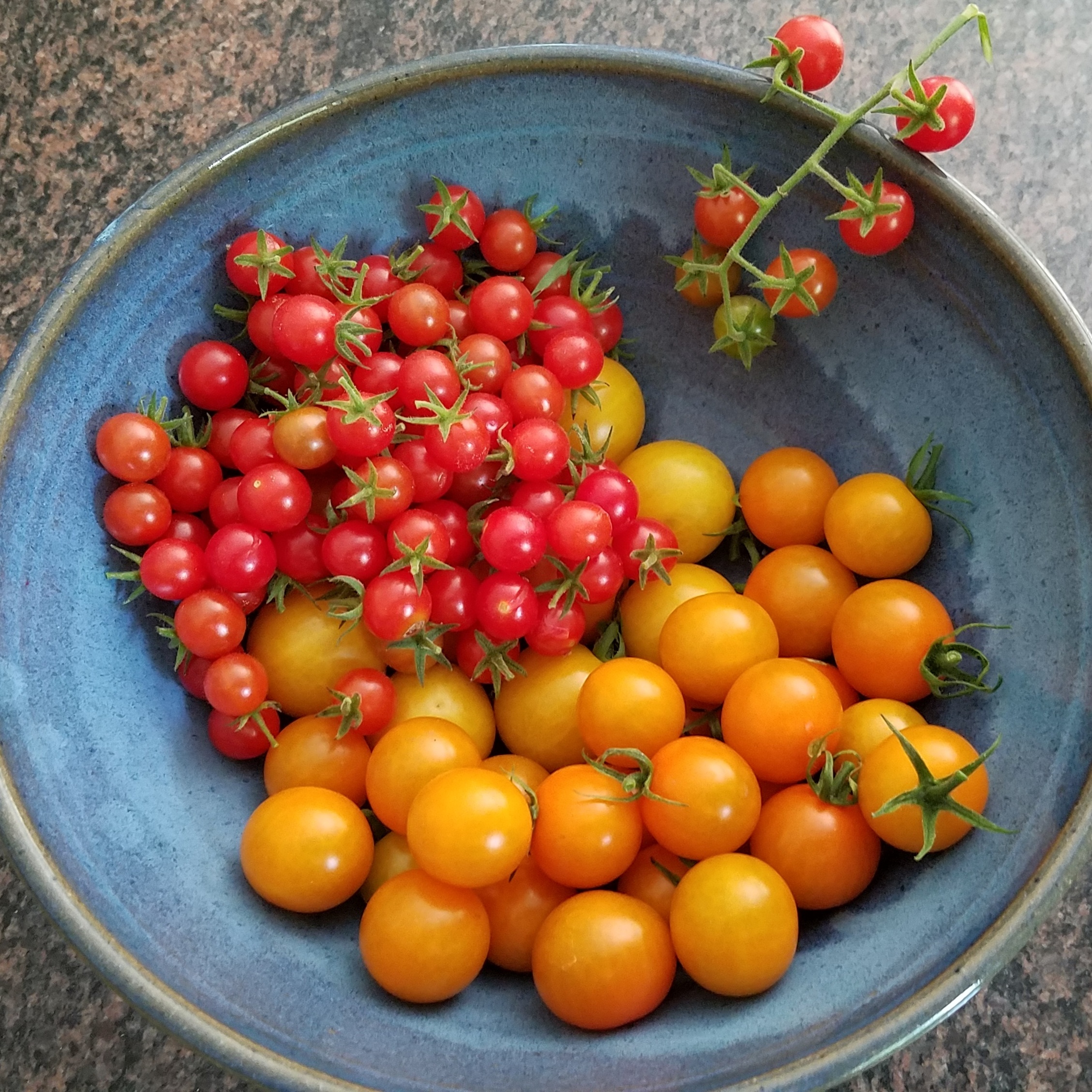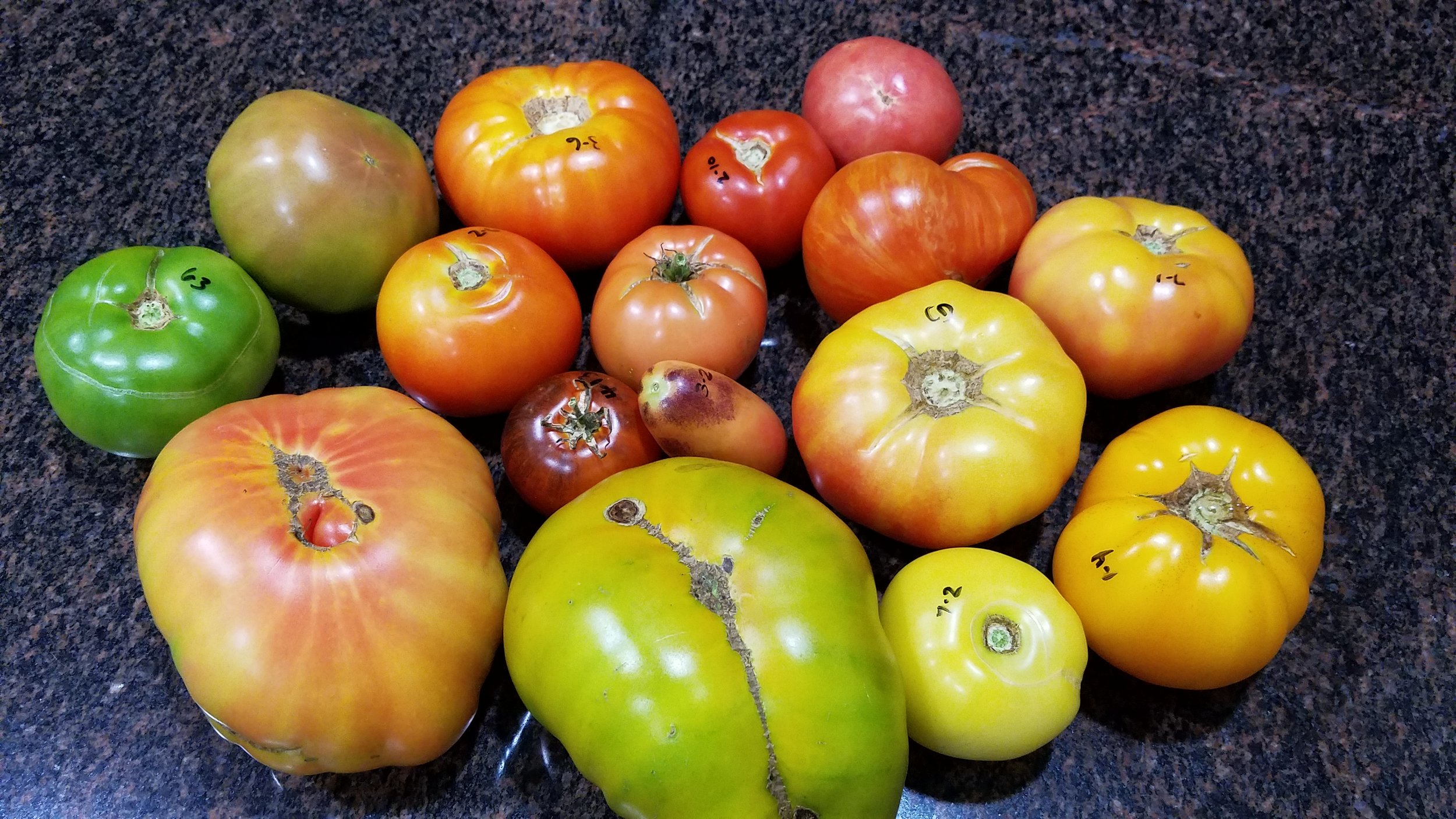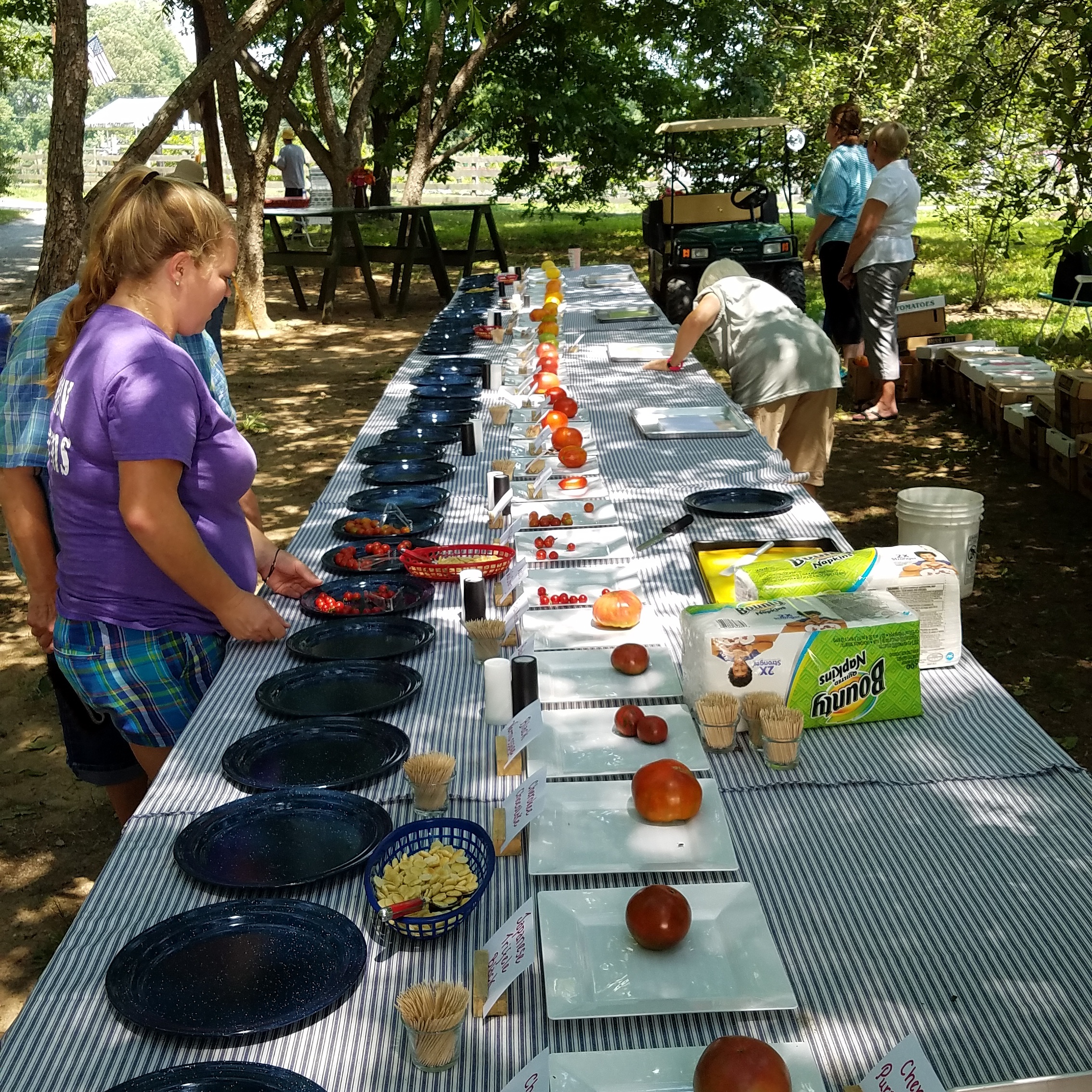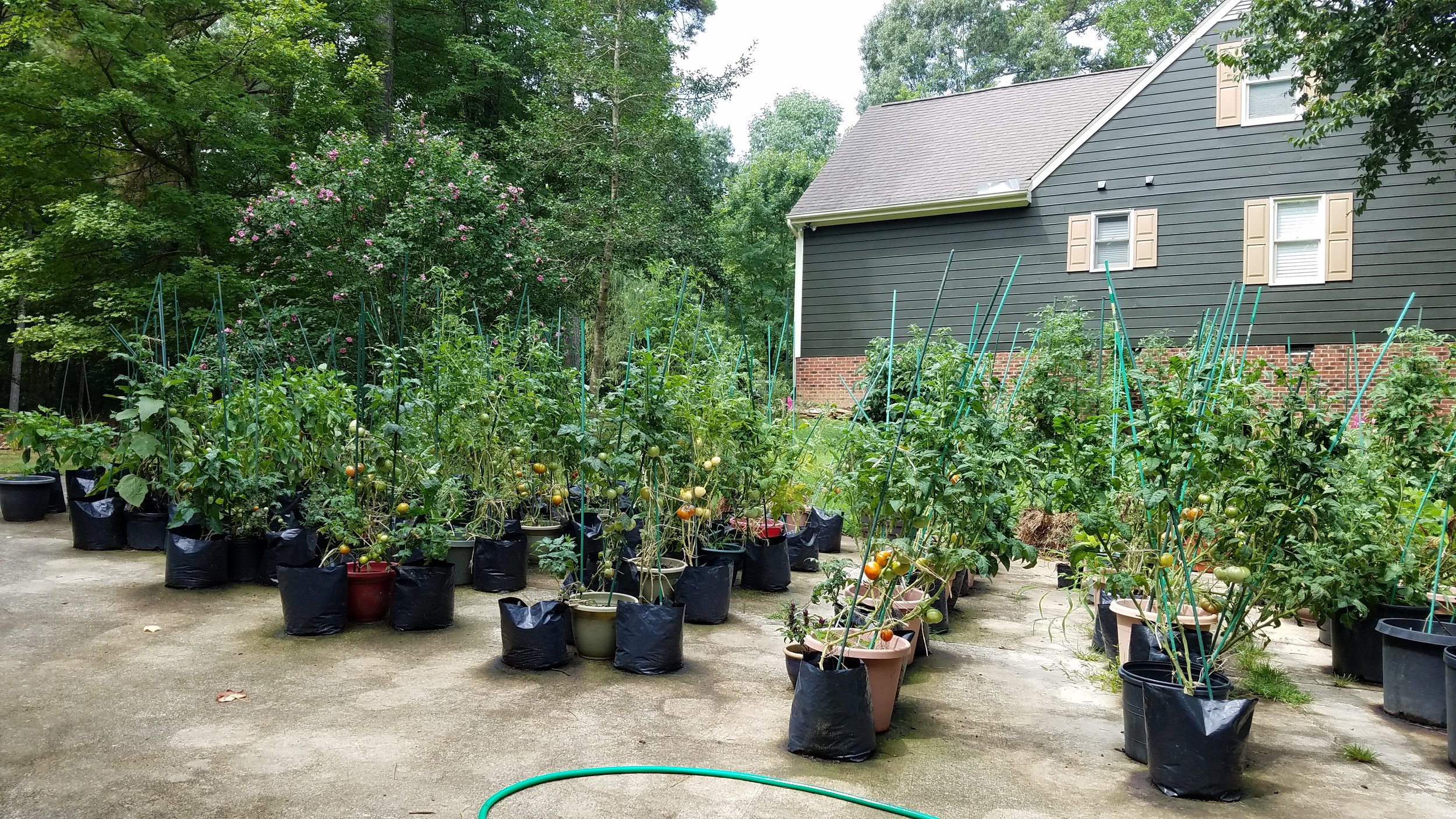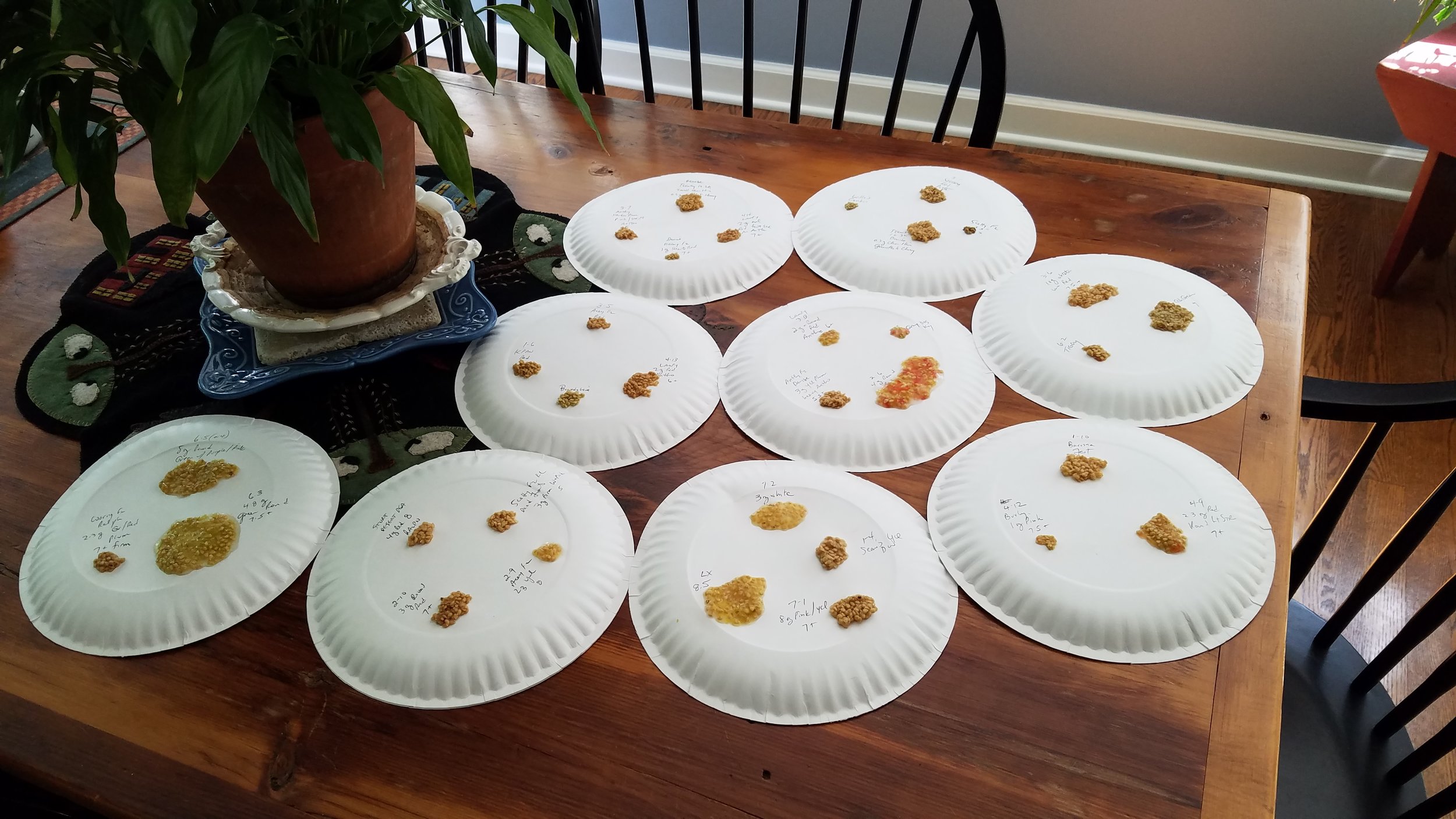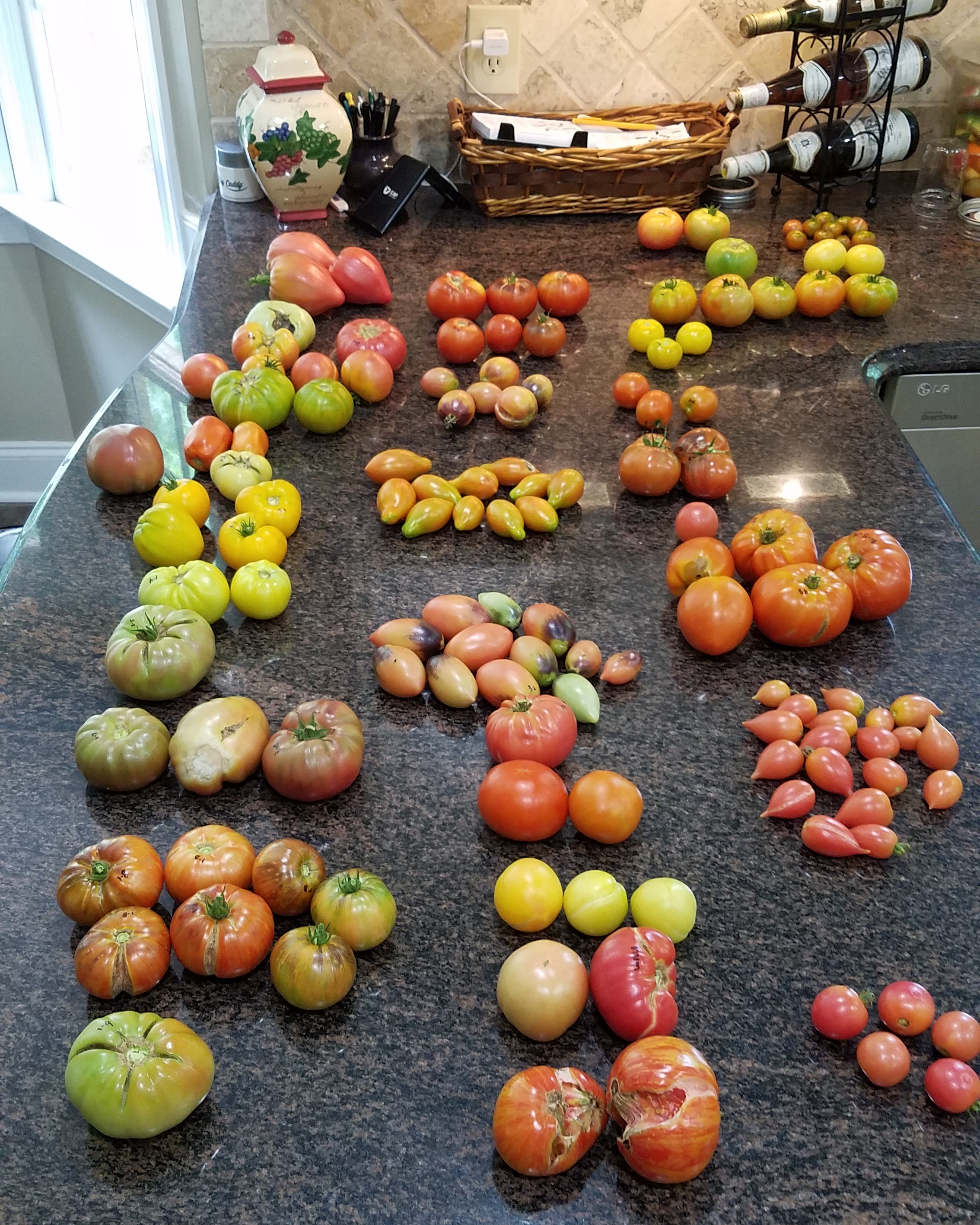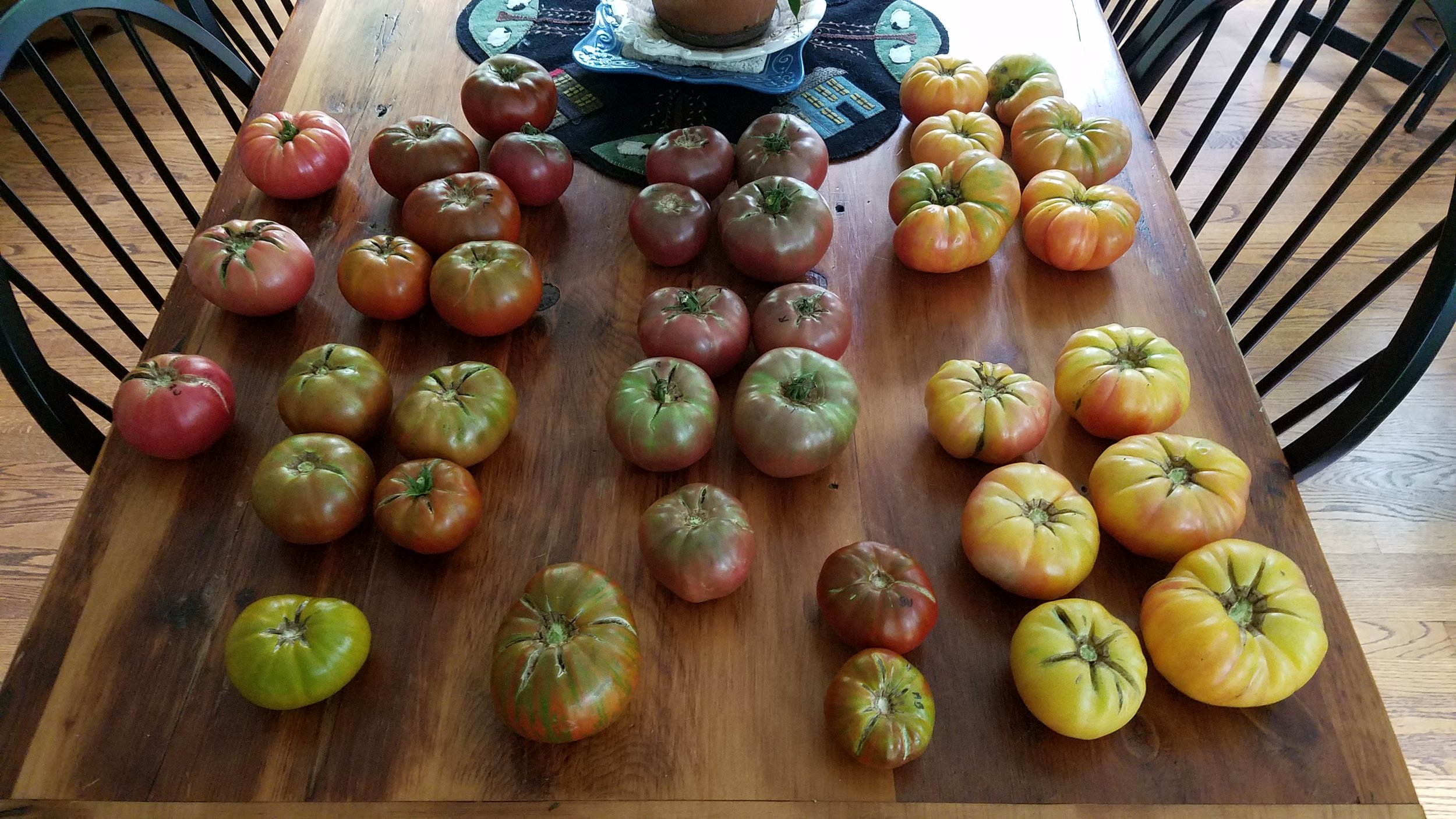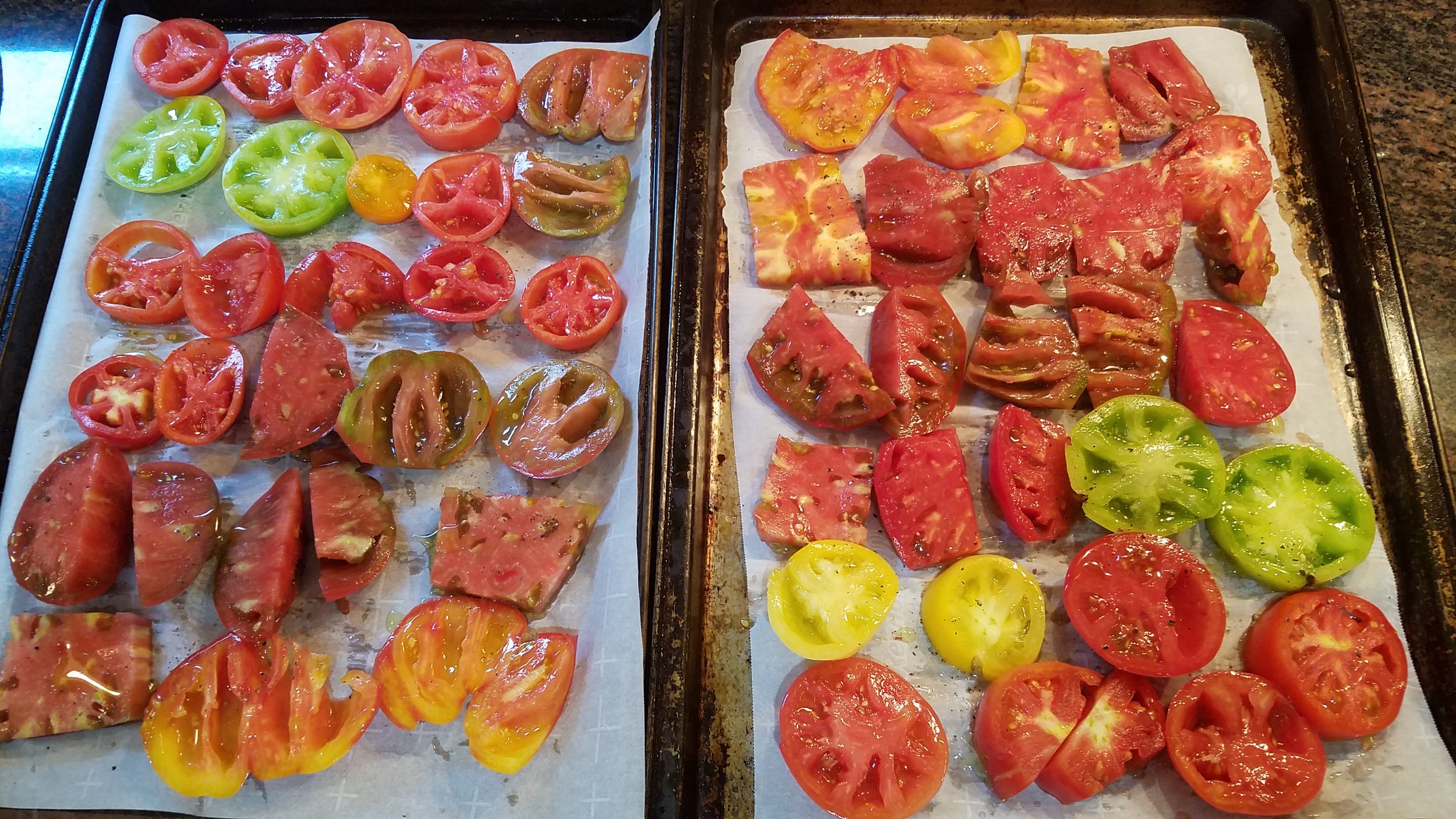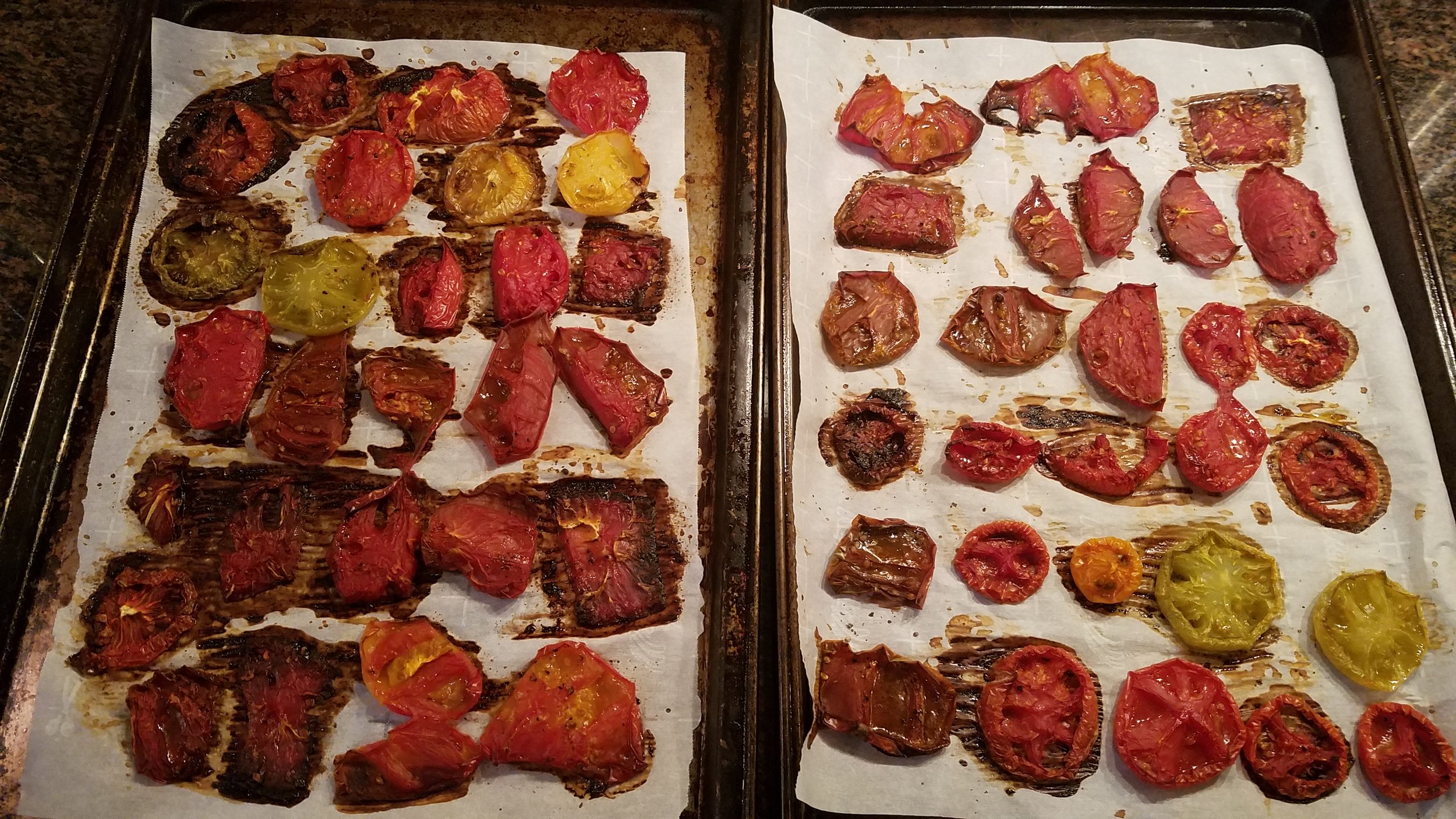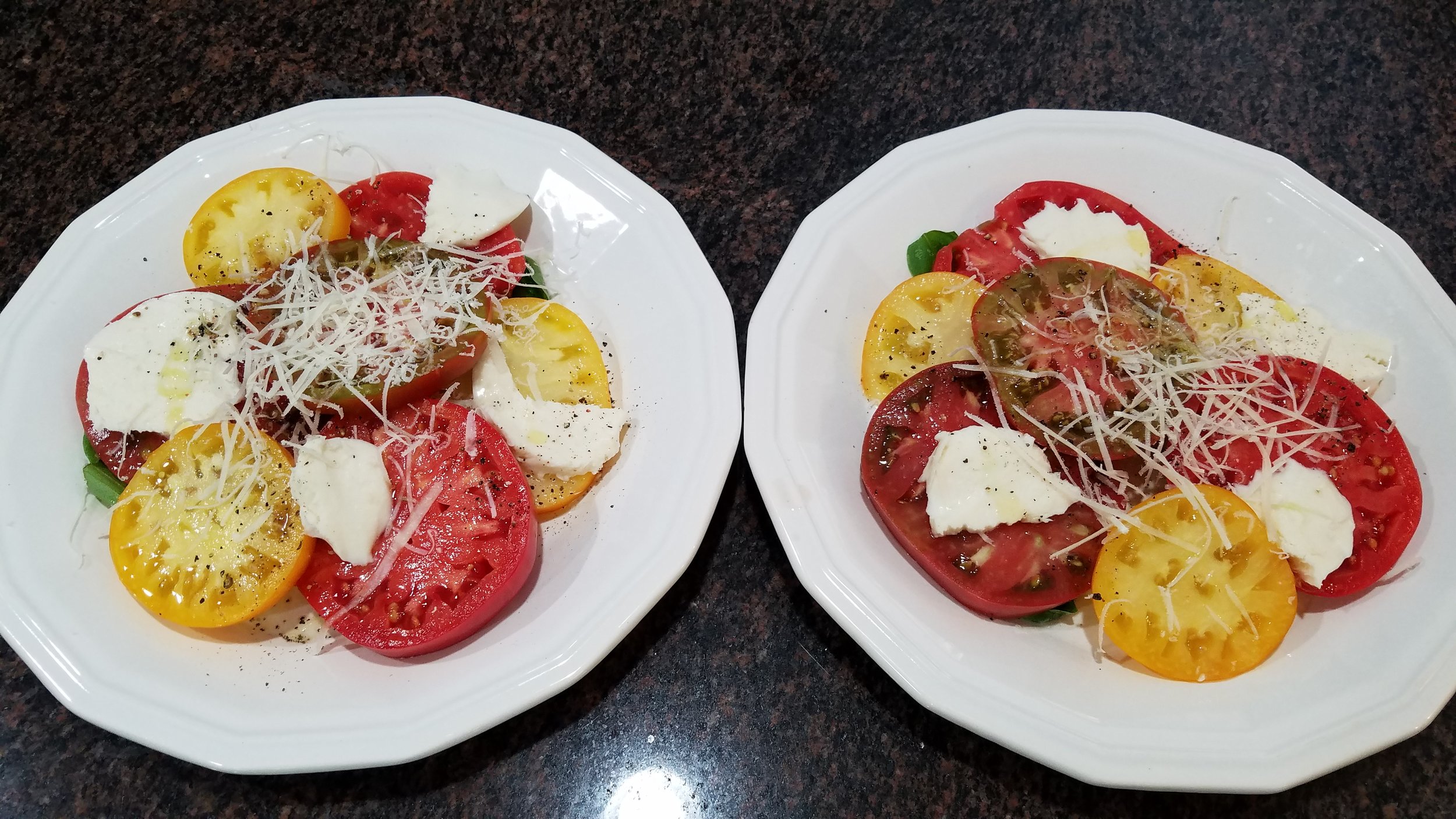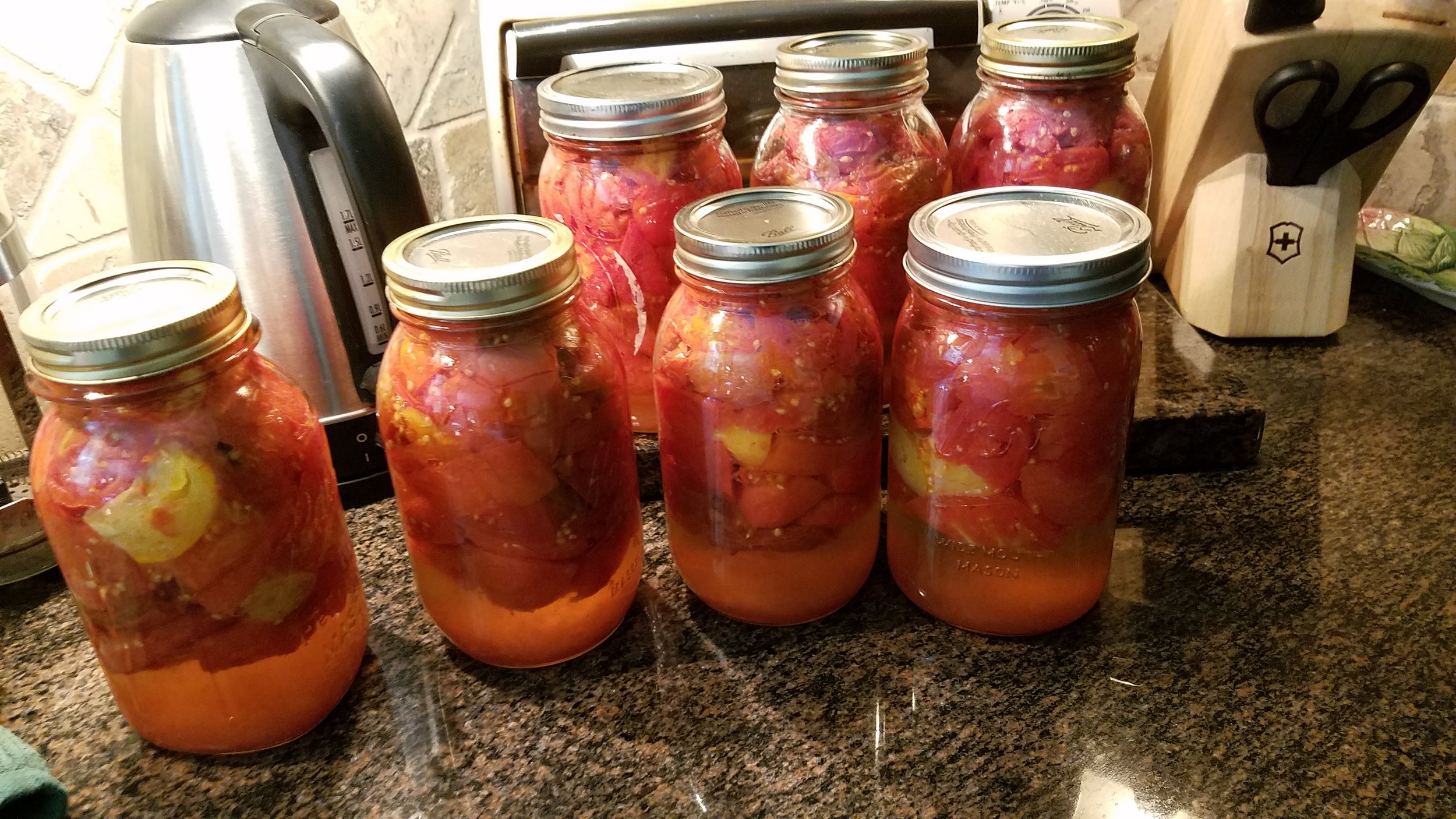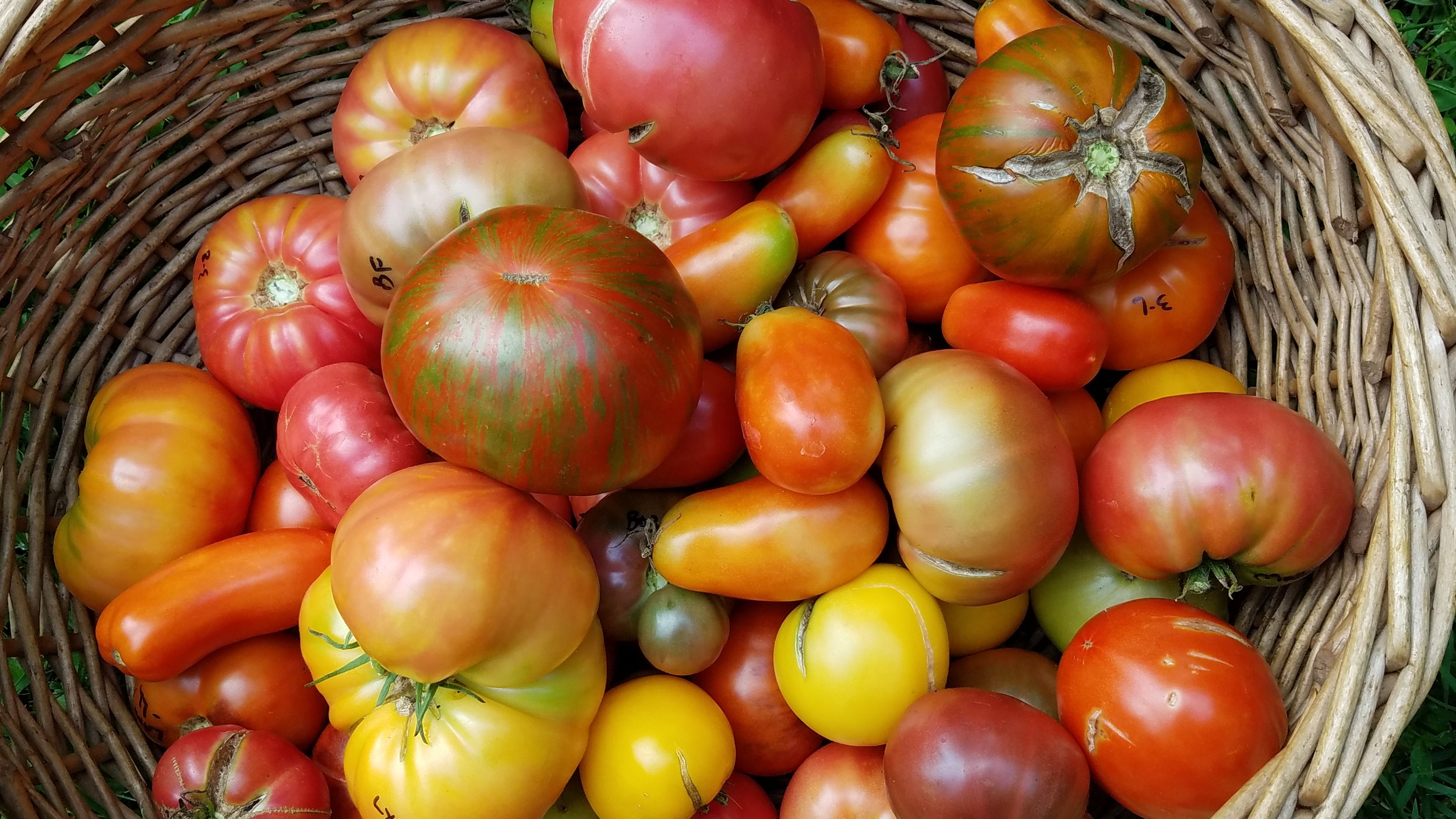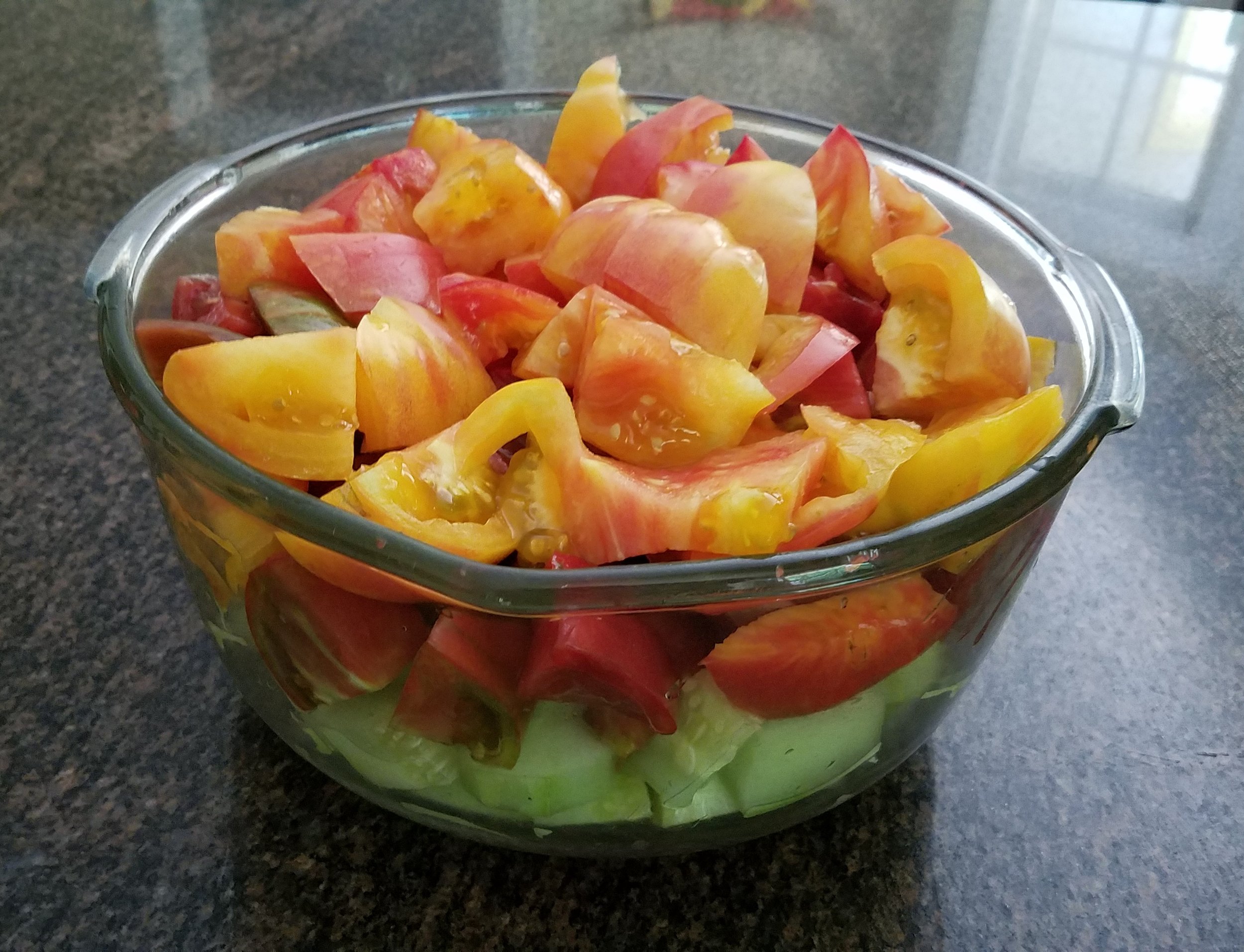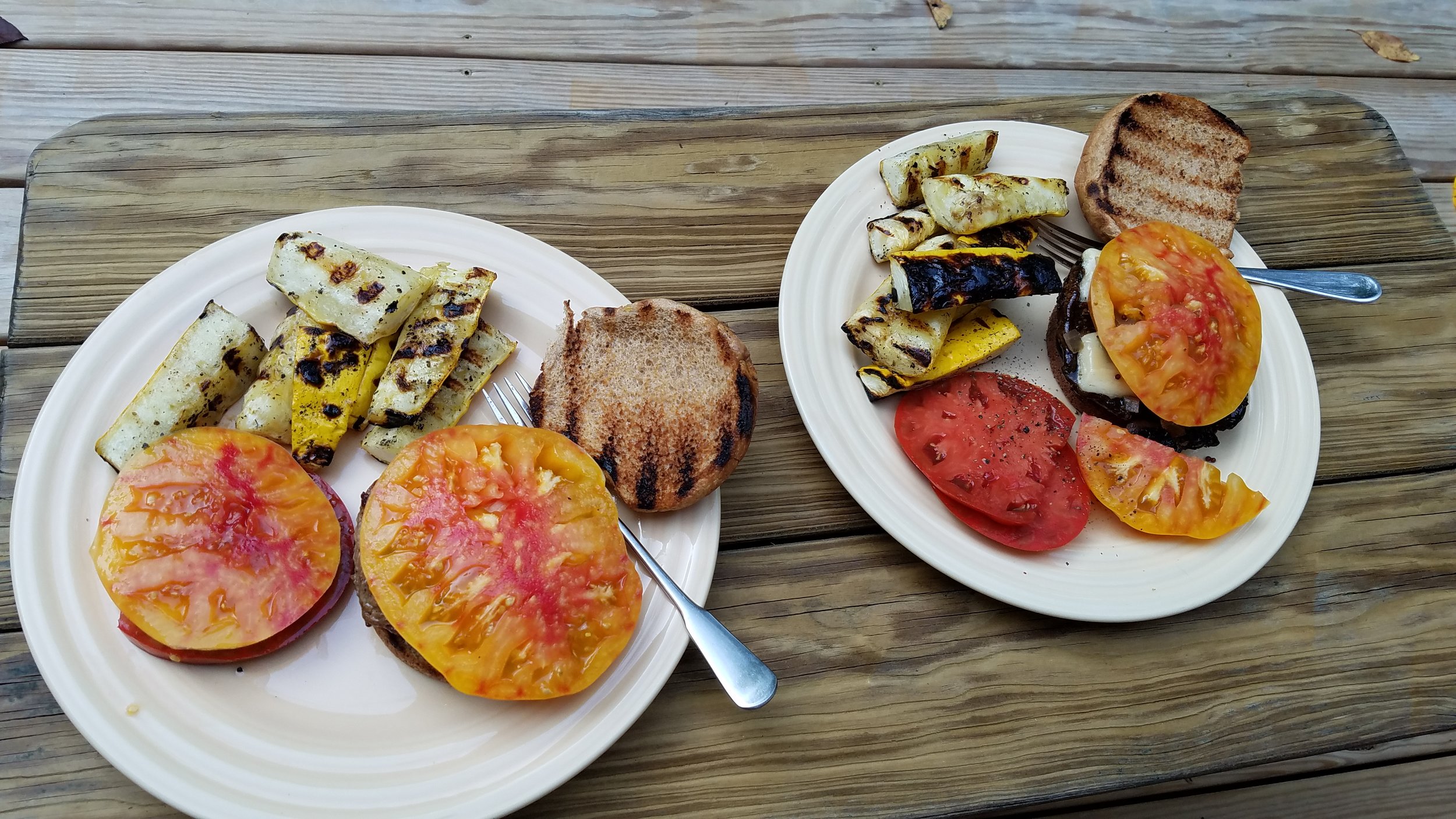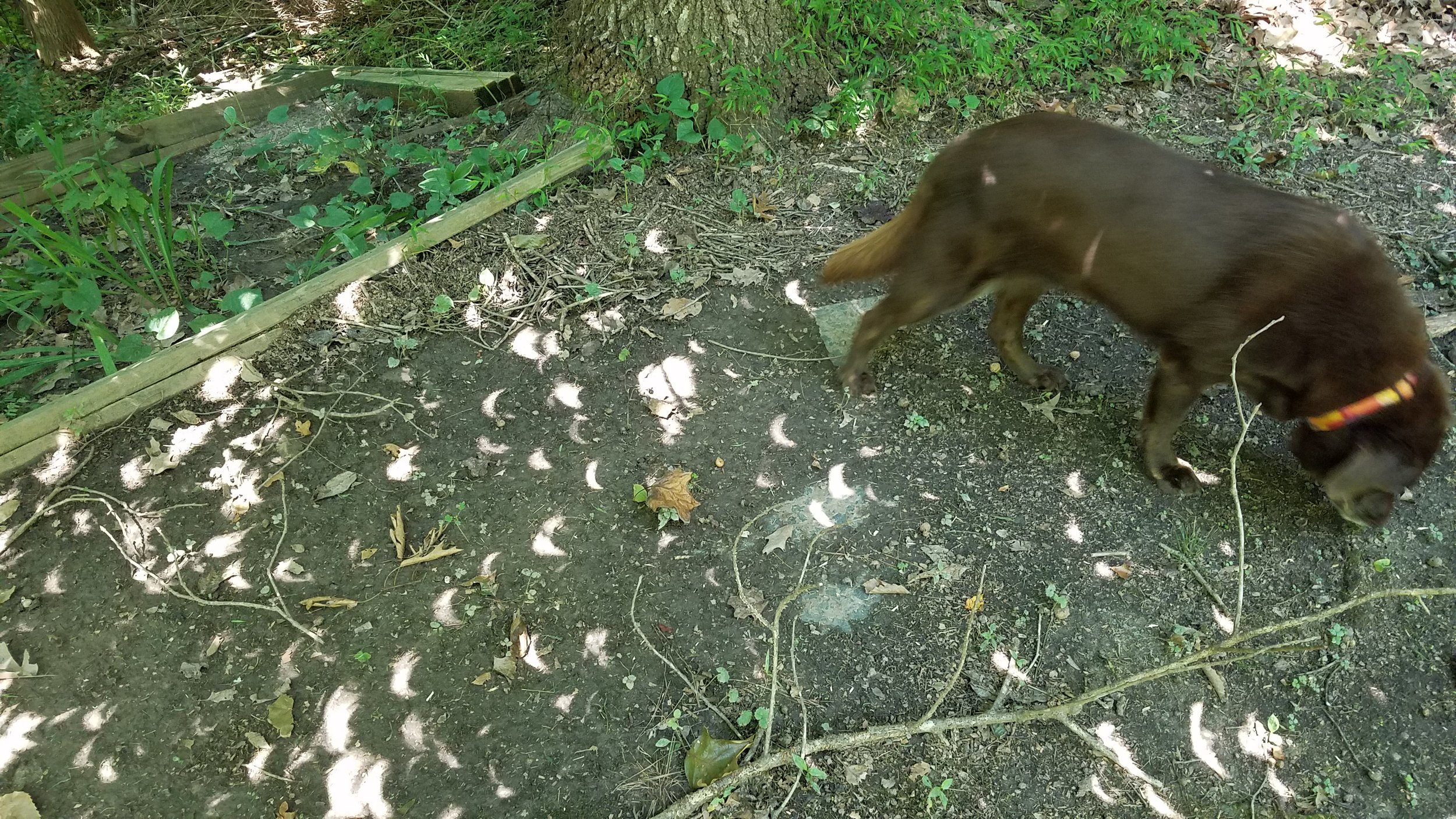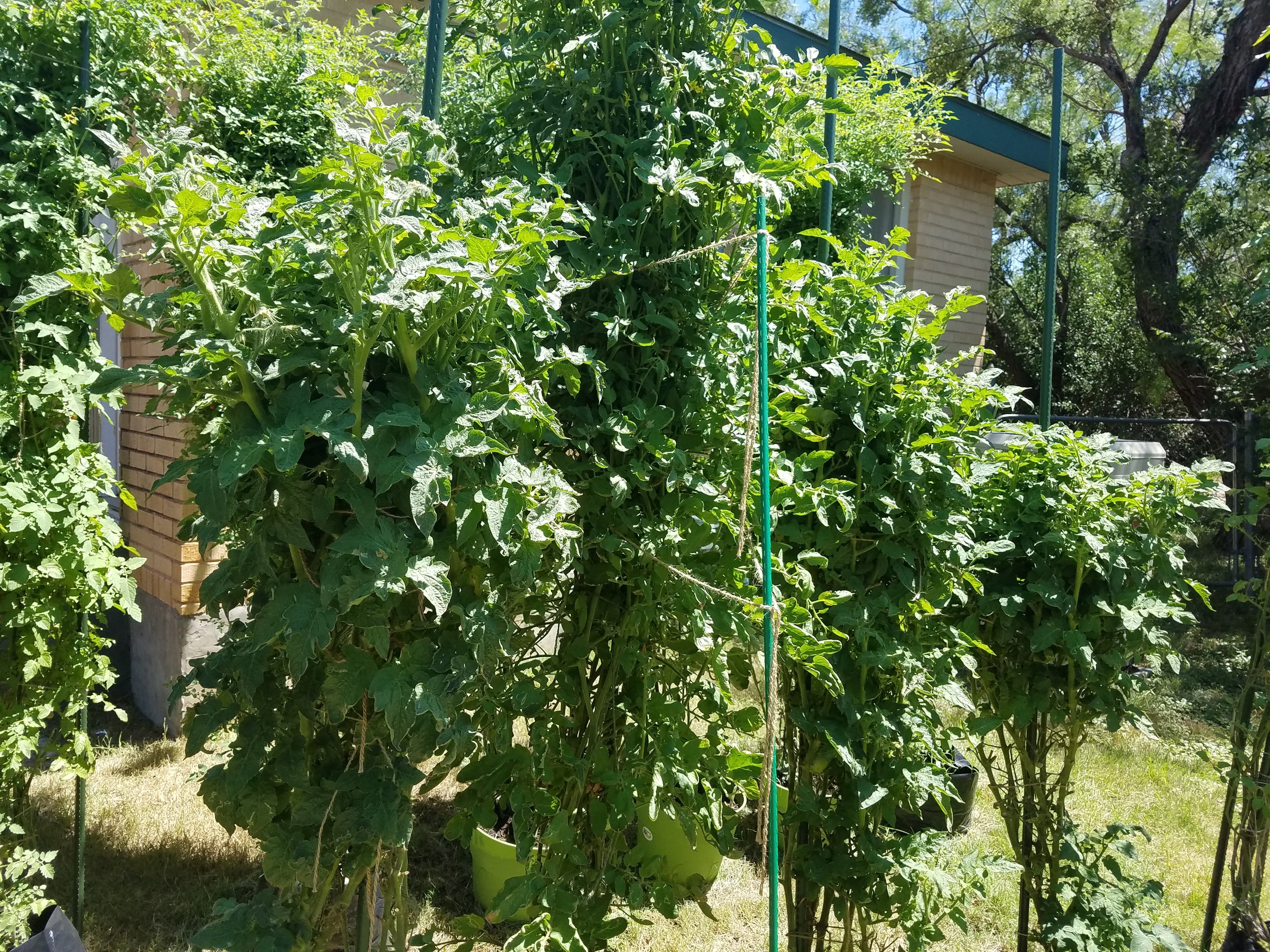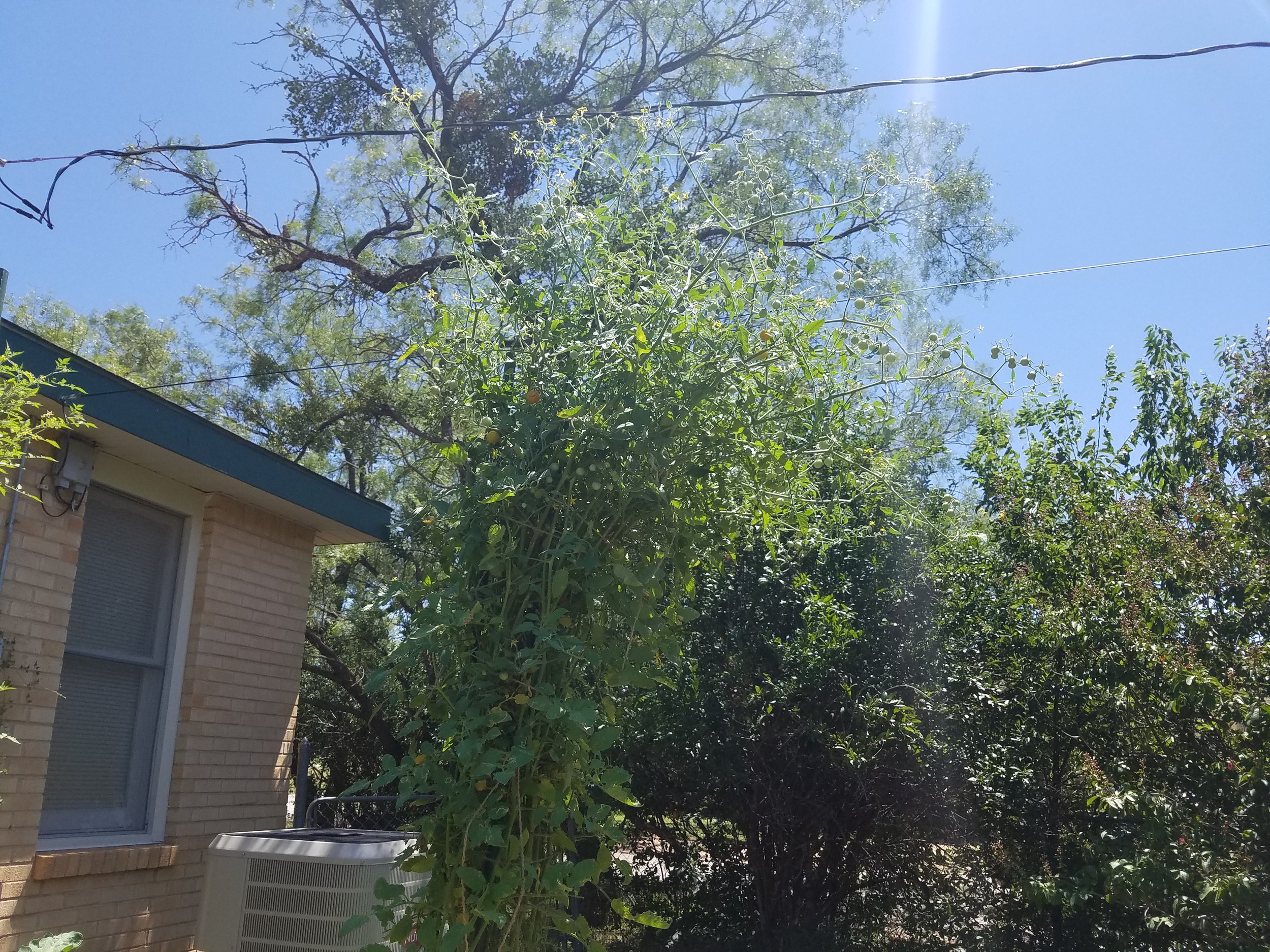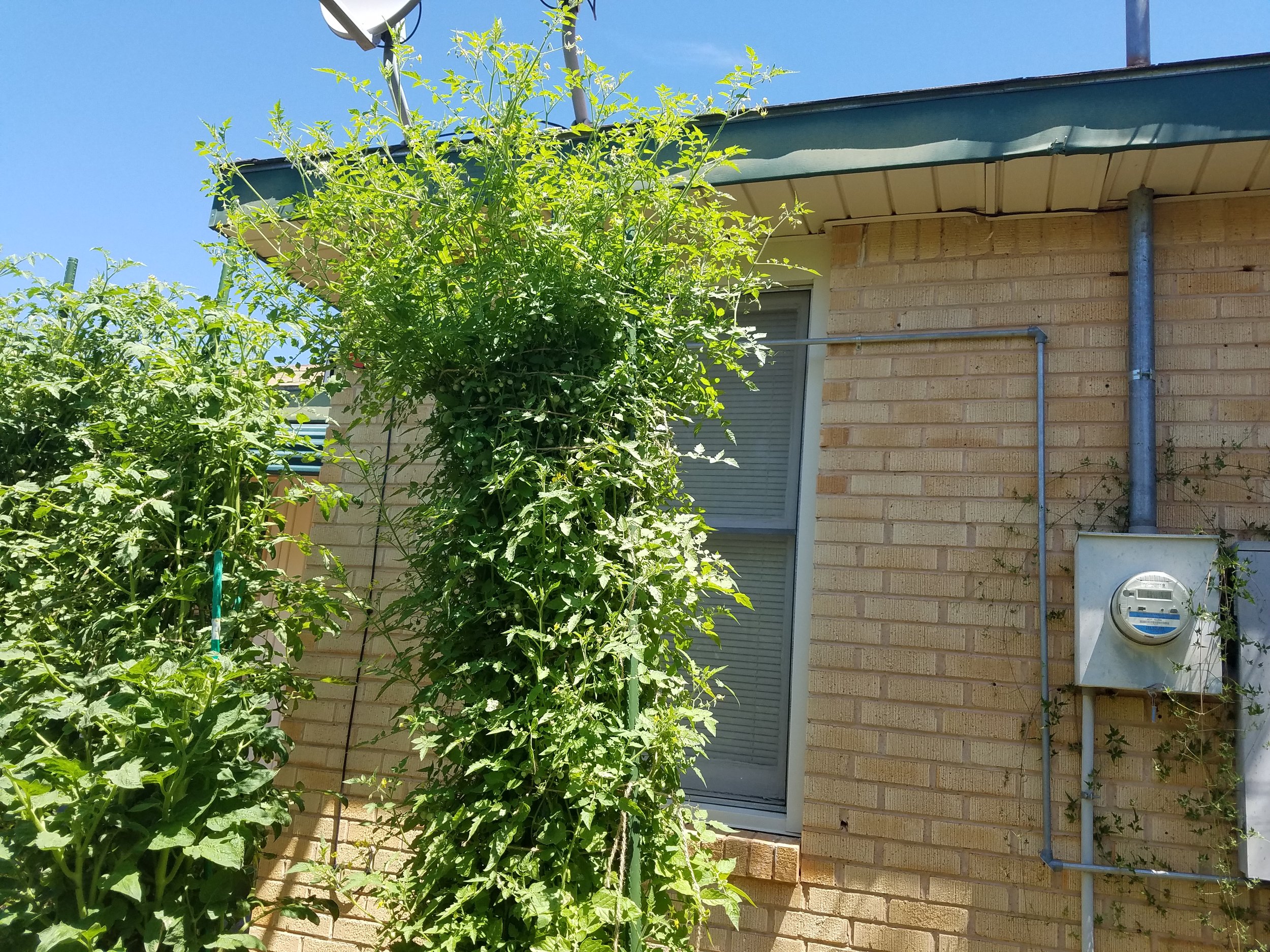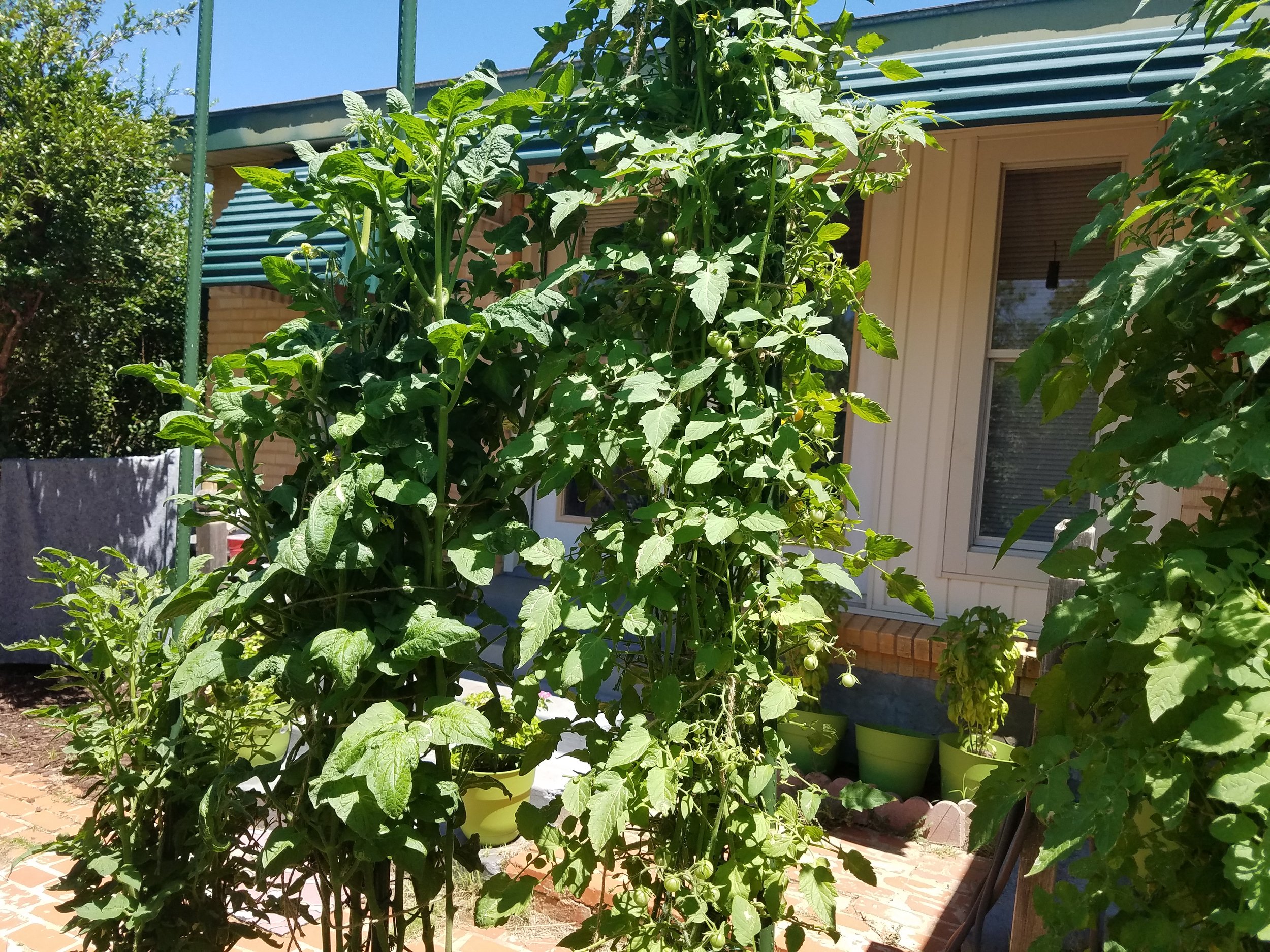I know that this is the update that lots of you are waiting to read....I've got some really curious, wild things growing out there for the Dwarf Tomato Breeding Project. Read on to find out which look to be winners, which dead ends, and which are yet to be determined.
Work toward worthwhile variegated foliage plants
Using the indeterminate tomato Variegated as pollen donor, four successful crosses represent the families in this category. During the seedling stage, I was surprised to find a fifth cross showing variegation (probably due to a double cross; more on that below).
Acey F2 potato leaf plant 1 - Acey is a cross between Variegated and Dwarf Mr. Snow, thus has the best chance of excellent flavor and good size, as well as potato leaf variegated plants. There are four offspring of this family in the garden. This lovely plant is healthy and vigorous - fruit set is fine, and the fruit seem to be round, and probably not very large. A-
Acey F2 potato leaf plant 2 - This plant is not as vigorous as plant 1 and got off to a slower start. Fruit set is just starting, and the flowers are not all that large - A-
Acey F2 regular leaf - This is the most impressive of the four Aceys, very vigorous, heavy fruit set, nice variegation. The fruit at this point vary from round to oblate and I expect this to have the largest fruit size. A
Acey F3 potato leaf - This plant came from seed from the single Acey offspring I squeezed in late last year, from small to medium oblate nearly white tomatoes. Struggling similarly to Acey F2 potato leaf plant 2, it is doing better, but behind - flowers, which are not too large, are just opening. B+
Artsy F2 plant 1 - Artsy is my cross between Variegated and Perth Pride. Artsy plant 1 is a lovely plant, with excellent fruit set. The tomatoes are in the 3 ounce range, smooth slightly oblate, and red in color. The flavor is very, very good - clearly better than the Variegated parent, with some of the nice tang of Perth Pride. This is a promising lead. A
Artsy F2 plant 2 - This is a bit of a mystery. The young seedling had quite fine foliage, clearly smaller than expected - making me wonder if some Silvery Fir Tree is included in this possibly complex cross. The plant is now quite large, with lovely variegation - it is now setting fruit, and the flowers are on the small side - can't wait to see what the fruit is like. A
Sandy F2 - Sandy is a cross between Variegated and the striped dwarf Sarandipity. My single Sandy offspring shows less variegation than the Acey or Artsy plants. Fruit set is very good and the plant is healthy. The tomatoes are in the 3 ounce range, slightly oblate, smooth, and red with faint lighter stripes, giving it a mottled appearance. The flavor is very good, certainly better than either parent. A
Fishy F2 - Fishy is a cross between Variegated and Iditarod Red - my expectations for this line are modest. The plant has only slight variegation, but is healthy and setting fruit well. The tomatoes are in the 3 ounce range, smooth slightly oblate, and very tasty - no surprise that it is a red tomato, like both parents. I like the flavor more than either parent. A
Scotty F2 - My aim in the Scotty cross was to start to delve into some of the E. C Green varieties offered by Livingston in the early 1900s - he was the first to use Honor Bright (a very unusual variety with nearly yellow foliage, white flowers, and tomatoes that go from white to red) as a parent, crossing it with some of the dwarfs of that time to eventually create yellow foliaged dwarfs. Scotty is a cross between a weird potato leaf, yellow leaf variety I found years ago in Turkey Chomp and call Surprise, with Dwarf Scarlet Heart. The offspring of this cross is very complex - potato and regular leaf, green and yellowish foliage - made even more mysterious by the presence of variegated foliaged plants. The single Scotty variegated plant looks fine - it is healthy and setting oblate fruit well. A
Work toward dwarf paste tomatoes
My work on dwarf paste tomatoes - primarily the Speckly family (my cross of Speckled Roman with Dwarf Golden Heart) - is limited this year. Yet, there is good news to report. The numbers below, and further on, are my reference vial numbers that were assigned to seed sent to me by project volunteers.
Speckly selection 5716 - moderately healthy, very compact dwarf, producing 2-3 ounce paste tomatoes with a nippled end - red in color, and quite flavorful. I'd like to see better production, but it is a good lead. B
Speckly selection 5994 - another very compact plant, healthy, tomatoes round to oval and red with faint stripes, very good flavor - A-
Speckly selection 5718 - healthy and vigorous, heavy yielding, fruit look to be 3-4 ounces and round to heart shaped. Yet to ripen, but soon - color and flavor pending - A
Work toward dwarf cherry tomatoes
I made quite a few crosses toward some great dwarf cherry tomatoes. I focused on a few from Burly (Sun Gold X Dwarf Beryl Beauty) and Steamy (Sun Gold X Dwarf Pink Passion) and one each from Reddy (Egg Yolk X Iditarod red), Zooty (Sun Gold X Tennessee Suited) and Teensy (Mexico Midget X Summertime Green); there are lots of volunteers working on these.
Burly selection 5992 - nice healthy 3 foot tall plant, lanky, good fruit set of oval large cherry tomatoes - should ripen soon. Tomatoes that gave the seeds were tasty and red - let's see what the color and flavor are like this year. A-
Burly selection 5778 - same growth habit, fruit set, shape and size as 5992 above. Expectations for this one are pink and delicious...we will soon see. A-
Steamy selection T16-24 - Lovely plant, stocky, healthy, loaded with fruit - beautiful fruit shape of a smooth teardrop, pink, sweet, nice flavor. Similar result to last year - working name for this is Liz's Teardrop, in memory of Sue's sister. One issue - the tomatoes have few to no seeds at all, which may be an issue. A-
Steamy selection T16-25 - Very similar to T16-24, with a slightly different shape - more of a mini paste - and not quite as heavy yielding - but with perhaps a slightly more intense flavor, and it does have some seeds. A-
Reddy selection 5784 - Healthy plant loading up with one ounce oval tomatoes that ripen a bright yellow. Very nice, lively flavor. Color of the father (Egg Yolk), fruit size half way between that and the mother (Iditarod Red). This is a nice lead, but needs to be compared to the released Kangaroo Paw Yellow to confirm it is distinct enough. A-
Teensy selection T16-41 - Healthy plant, on the tall side for a dwarf - half way between a dwarf and an indeterminate, probably due to the Mexico Midget parentage. Healthy plant with great fruit set, small cherry tomatoes that ripen chocolate brown, very good flavor, juicy. Lots of people are working on this, so results will be compared. Certainly a fine dwarf cherry, and good candidate for release. A-
Zooty F2 - now this is a find! Nice compact dwarf; had lots of disease early (very dense plant), but that was removed and it looks fine. Fruit are small to small/medium oblate, orange with green stripes, and delicious! Only tried one so far, looking forward to more....some of that Sun Gold flavor is coming through. A-
Work toward good tasting high anthocyanin dwarfs
These are fun, complex lines to work with, and the goal is to create unique looking, high anthocyanin colored dwarfs with good flavor (the main high antho variety, Oregon Blue P20, simply doesn't taste very good). The two main families are Anthy (a high antho pink determinate cherry sent to be by gardening friend Marcia, crossed with our green striped plum shaped dwarf Saucy Mary), and Lampy (Oregon Blue P20 X Tennessee Suited - a cross I made while being filmed for the Growing a Greener World episode; the aim is to create a tomato for Joe Lamp'l meeting his preferences that he can name and we can work on together).
Anthy plant 1 - heavy yielding, spreading dwarf plant, loads of small roma-shaped tomatoes, doesn't appear to have stripes or antho at this point. Awaiting ripe color. A
Anthy plant 2 - heavy yielding, spreading dwarf plant, really loaded with unusual slender paste types - more slender than usual - light and dark stripes, no antho, ripening to an orangey red with stripes, but still waiting for full ripening, which is a few days away. Very interesting looking. A
Anthy plant 3 - heavy yielding spreading dwarf plant, loaded with 2 ounce egg shaped tomatoes with strong antho showing, seems to be ripening to pink - just a few days away. Hoping it tastes good, because it sure is productive and interesting looking. A
Anthy plant 4 - very compact dwarf, big set first few clusters - seems to be ready to blossom again. Egg shaped 2 ounce purple fruit, strong antho shoulders, no stripes, very good flavor. Worth pursuing - A-
Lampy plant 1 - nice typical dwarf growth, healthy, good fruit set; tomatoes are round to slightly oblate, 2-3 ounces, good antho coloring on shoulders - color red or chocolate, no stripes (need to let one ripen a bit more) - sadly, the flavor isn't there - too mild. A
Lampy plant 2 - high fruit set, nice plant, healthy, medium sized oblate fruit now showing antho shoulder blush, awaiting ripening and checking for stripes. A
Lampy plant 3 - very high yield, healthy, like a short indeterminate, loading up with medium small round fruit, strong antho. Stripes? Color? Not yet there. Hoping for the flavor. It is likely the best approach will be to size up the best Lampy selections that show strong antho by crossing with a larger delicious purple or chocolate indeterminate. A
Lampy plant 4 - nice yield, small to medium round to slightly oblate fruit, faint antho, faint stripes, color appears to be red or chocolate with faint green stripes, good tart flavor - interesting. A
Lampy plant 5 - rescued a clearly purplish stemmed dwarf that was in a 3.5 inch pot for a long time, planted late, but now doing well - setting lots of fruit. Can't determine size, antho, color or stripes yet. A-
Lampy plant 6 - similar rescue to plant 5 - similar status - will take some time. A-
Work toward pale foliaged dwarfs - either yellow toned, or chartreuse toned
I am growing only one offspring in the Morty line that is showing distinct chartreuse foliage (Morty is Charlotte Mullens Mortgage Lifter X Summer Sunrise). The real oddity is the Scotty line, described above in the Variegated section. See below for the specifics.
Morty selection T16-184 - Last year this was a lovely potato leaf chartreuse foliaged plant with medium to large red oblate tasty tomatoes. This year the plant looks as expected - a dwarf, but on the tall side - the chartreuse color gene seems to "stretch" the plants, making dwarfs and indeterminates with that leaf color particularly lanky. Fruit set is good and the plant is healthy - will be late, though. A-
A curious note on Scotty - aside from the Variegated dwarf, all of the Scotty seedlings show distinct spotting - different from Septoria - pretty much all the way up the plant, starting on the lowest leaves. They in general don't look very healthy - wondering if the cross revealed some genetic disease susceptibility.
Scotty plant 1 - Potato leaf dwarf with the yellowish foliage of the Surprise parent. It is setting fruit - just an odd looking plant. Not near ripe yet. B
Scotty plant 2 - Potato leaf dwarf that looks very similar to plant 1 above - B
Scotty plant 3 - Regular leaf tending yellowish foliage, now battling disease, so quarantined. Unripe fruit are oblate to round and snow white, like the Surprise parent. I will get a few seeds of this, but the plant is not long for my garden. C-
Scotty plant 4 - Regular leaf, not diseased, but certainly odd...setting oblate fruit. B
Other dwarf families with no particular category aside from curiosity (it is worth noting that another family I really wanted to explore never got planted by me - Addy....fortunately, some local volunteers are growing some Addy dwarfs. Addy is Yellow White X Sweet Adelaide)
The following plants are from 2 families that I initially mis-named. Leafy is a cross between Yellow White (aka Viva's Kentucky Heirloom, a 1920s large white indeterminate type, and Dwarf Jade Beauty. Betty is a cross between chartreuse leaf Mullens Mortgage Lifter and Dwarf Jade Beauty. Originally, I called the Leafy cross Betty and vice versa, but when chartreuse seedlings started coming up in Betty, and none in Leafy, I realized my error. Interestingly, the following four plants all look superb and promising. I think that these four may produce some of the larger fruited dwarfs (aside from the 20 or so releases I am growing)
Leafy F2 regular leaf - very healthy, good fruit set of medium smooth fruit - nice plant - what color will it be? A
Leafy F2 potato leaf - as healthy as the regular leaf, fruit size perhaps larger, A
Betty F2 regular leaf - healthy, lots of 3-4 oz smooth oblate fruit, look to get larger, A
Betty F2 potato leaf - healthy, similar fruit to the regular leaf at the moment, A
Odds and ends - microdwarfs and Stick offspring
My gardening friend Dan sent me a few interesting crosses he did in work toward interesting multiflora microdwarfs - one involving Silvery Fir Tree, the other Stick, each with crosses with microdwarfs or multifloras.
SFT X MMF plant 1 - carrot like foliage like Silvery Fir Tree, 1 oz to slightly larger oblate fruit, pretty tasty, nothing too special. A-
SFT X MMF plant 2 - similar to plant 1 but perhaps a bit more spreading, fruit slightly larger but not as tasty. A-
SFT X MMF plant 3 - rather bizarre tall (perhaps indeterminate), foliage midway between regular leaf and carrot leaf and strongly blue green tinted, setting round fruit, probably not large, not yet ripe, inner foliage has disease that needs lots of pruning (very dense) A-
SFT X MMF plant 4 - initially the smallest of the bunch and nearly lost to foliage disease, but making a come back. Very similar to plants 1 and 2. A-
SFT X MMF plant 5 - now this one is a micro dwarf, but a bit taller than the classic, Red Robin - and is multiflora - loads of blossoms, not all of which set. Red cherry type fruit nearly ripe. A-
Stick X Micro plant 1 - Typical microdwarf but not poor yield, fair flavor - red cherry fruit - now dead and gone.
Stick X Micro plant 2 - another typical microdwarf but fair yield - not nearly as high as Red Robin - pretty good flavored red cherry - A-
Stick X Micro plant 3 - Looks like the bizarro variety Stick, but with smaller, cherry sized fruit that taste pretty good....a curiosity only. A-


